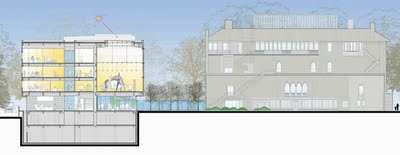The Gardner Museum addition

From our report on unveiling of Italian architect Renzo Piano's designs for an addition to the Isabella Stewart Gardner Museum in Boston:
On January 1, 1903, Isabella Stewart Gardner invited 300 guests to a private concert by members of the Boston Symphony Orchestra to celebrate the opening of her new museum on the Fenway. After performances of Bach, Mozart, and Schumann, the mirrored doors of the first-floor concert room rolled open to reveal an extraordinary vision: a four-story-tall courtyard in the center of the building filled with flowers and lit by Japanese paper lanterns.Read the rest here.
Guests wandered off into candlelit galleries, each lavishly furnished with a mix of old master paintings (Botticelli, Titian, Vermeer, Rembrandt), contemporary works (John Singer Sargent), antique furniture, architectural details, and tapestries. When they sat down to supper in a second-floor gallery full of 17th-century Dutch masterpieces, many must have shared the thoughts of philosopher William James. "The æsthetic perfection of all things," he wrote, "seemed to have a peculiar effect on the company, making them quiet and docile and self-forgetful and kind. Quite in the line of a Gospel miracle!"
In our era, when museums increasingly feel like the group-think of corporate teams, Gardner's ravishing, theatrical, treasure-packed, idiosyncratic one-woman gesamtkunstwerk is ever more a miracle. On January 21, when the Gardner Museum unveiled Italian architect Renzo Piano's designs for an addition, the question was whether his sleek, boxy, copper-clad, glass-and-steel structure, at a cost of $114 million, would sap and distract from Gardner's original Venetian Renaissance-inspired palazzo.
Previously:
March 5, 2009: Court oks Gardner expansion, demolition.
March 5, 2009: Court’s ruling on Gardner.
March 9, 2009: Gardner buildings slated for demolition.
July 7, 2009: Gardner carriage house RIP.
Pictured from top to bottom: Rendering from Evans Way Park; section through the special exhibition gallery; elevation from Palace Road; and elevation from Evans Way Park. Note that these illustrations below can be misleading because they suggest transparent walls in the upper floors of the Gardner addition, which we're told will actually be clad in opaque copper. All pictures © Renzo Piano Building Workshop.









0 Comments:
Post a Comment
<< Home